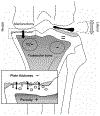Regenerative Engineering Animal Models for Knee Osteoarthritis
- PMID: 35958163
- PMCID: PMC9365239
- DOI: 10.1007/s40883-021-00225-y
Regenerative Engineering Animal Models for Knee Osteoarthritis
Abstract
Osteoarthritis (OA) of the knee is the most common synovial joint disorder worldwide, with a growing incidence due to increasing rates of obesity and an aging population. A significant amount of research is currently being conducted to further our understanding of the pathophysiology of knee osteoarthritis to design less invasive and more effective treatment options once conservative management has failed. Regenerative engineering techniques have shown promising preclinical results in treating OA due to their innovative approaches and have emerged as a popular area of study. To investigate these therapeutics, animal models of OA have been used in preclinical trials. There are various mechanisms by which OA can be induced in the knee/stifle of animals that are classified by the etiology of the OA that they are designed to recapitulate. Thus, it is essential to utilize the correct animal model in studies that are investigating regenerative engineering techniques for proper translation of efficacy into clinical trials. This review discusses the various animal models of OA that may be used in preclinical regenerative engineering trials and the corresponding classification system.
Keywords: Animal models; Osteoarthritis; Preclinical trials; Regenerative engineering; Translation.
Conflict of interest statement
Conflict of Interest Dr. Cato Laurencin serves as the Editor-in-Chief of the journal Regenerative Engineering and Translational Medicine. Dr. Cato Laurencin serves on the board of directors for MiMedEx, Inc.
Figures






Similar articles
-
Animal Models of Osteoarthritis: Updated Models and Outcome Measures 2016-2023.Regen Eng Transl Med. 2024 Jun;10(2):127-146. doi: 10.1007/s40883-023-00309-x. Epub 2023 Jun 27. Regen Eng Transl Med. 2024. PMID: 38983776 Free PMC article.
-
Regenerative Engineering for Knee Osteoarthritis Treatment: Biomaterials and Cell-Based Technologies.Engineering (Beijing). 2017 Feb;3(1):16-27. doi: 10.1016/j.eng.2017.01.003. Epub 2017 Feb 14. Engineering (Beijing). 2017. PMID: 35392109 Free PMC article.
-
A Roadmap of In Vitro Models in Osteoarthritis: A Focus on Their Biological Relevance in Regenerative Medicine.J Clin Med. 2021 Apr 28;10(9):1920. doi: 10.3390/jcm10091920. J Clin Med. 2021. PMID: 33925222 Free PMC article. Review.
-
Arthroscopic lavage and debridement for osteoarthritis of the knee: an evidence-based analysis.Ont Health Technol Assess Ser. 2005;5(12):1-37. Epub 2005 Sep 1. Ont Health Technol Assess Ser. 2005. PMID: 23074463 Free PMC article.
-
Preclinical studies and clinical trials on mesenchymal stem cell therapy for knee osteoarthritis: A systematic review on models and cell doses.Int J Rheum Dis. 2022 May;25(5):532-562. doi: 10.1111/1756-185X.14306. Epub 2022 Mar 4. Int J Rheum Dis. 2022. PMID: 35244339
Cited by
-
Hyaluronic acid-British anti-Lewisite as a safer chelation therapy for the treatment of arthroplasty-related metallosis.Proc Natl Acad Sci U S A. 2023 Nov 7;120(45):e2309156120. doi: 10.1073/pnas.2309156120. Epub 2023 Oct 30. Proc Natl Acad Sci U S A. 2023. PMID: 37903261 Free PMC article.
-
Microphysiological System-Generated Physiological Shear Forces Reduce TNF-α-Mediated Cartilage Damage in a 3D Model of Arthritis.Adv Sci (Weinh). 2025 Feb;12(7):e2412010. doi: 10.1002/advs.202412010. Epub 2024 Dec 24. Adv Sci (Weinh). 2025. PMID: 39716911 Free PMC article.
-
Animal Models of Osteoarthritis: Updated Models and Outcome Measures 2016-2023.Regen Eng Transl Med. 2024 Jun;10(2):127-146. doi: 10.1007/s40883-023-00309-x. Epub 2023 Jun 27. Regen Eng Transl Med. 2024. PMID: 38983776 Free PMC article.
-
Magnesium phosphate functionalized graphene oxide and PLGA composite matrices with enhanced mechanical and osteogenic properties for bone regeneration.Regen Biomater. 2025 Jul 26;12:rbaf074. doi: 10.1093/rb/rbaf074. eCollection 2025. Regen Biomater. 2025. PMID: 40837704 Free PMC article.
-
Effects of Etanercept on Experimental Osteoarthritis in Rats: Role of Histone Deacetylases.Cartilage. 2024 Jul 26:19476035241264012. doi: 10.1177/19476035241264012. Online ahead of print. Cartilage. 2024. PMID: 39057748 Free PMC article.
References
-
- Laurencin Cato T., Khan Y. Regenerative engineering - Google books. (Laurencin Cato T., Khan Y, ed.). CRC Press/Taylor & Francis Group; 2013.
-
- Ibim SEM, Uhrich KE, Attawia M, Shastri VR, el-Amin SF, Bronson R, Langer R, Laurencin CT Preliminary in vivo report on the osteocompatibility of poly(anhydride- co-imides) evaluated in a tibial model. In: Journal of Biomedical Materials Research. Vol 43. John Wiley & Sons Inc; 1998:374–379. 10.1002/(SICI)1097-4636(199824)43:4<374::AID-JBM5>3.0.CO;2-5 - DOI - PubMed
Grants and funding
LinkOut - more resources
Full Text Sources
